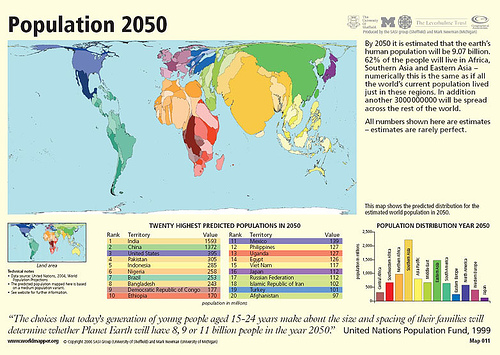Planet could be ‘unrecognizable’ by 2050, experts say

A growing, more affluent population competing for ever scarcer resources could make for an “unrecognizable” world by 2050, researchers warned at a major US science conference Sunday. The United Nations has predicted the global population will reach seven billion this year, and climb to nine billion by 2050, “with almost all of the growth occurring in poor countries, particularly Africa and South Asia,” said John Bongaarts of the non-profit Population Council.
To feed all those mouths, “we will need to produce as much food in the next 40 years as we have in the last 8,000,” said Jason Clay of the World Wildlife Fund at the annual meeting of the American Association for the Advancement of Science (AAAS).
“By 2050 we will not have a planet left that is recognizable” if current trends continue, Clay said.
The swelling population will exacerbate problems, such as resource depletion, said John Casterline, director of the Initiative in Population Research at Ohio State University. But incomes are also expected to rise over the next 40 years — tripling globally and quintupling in developing nations — and add more strain to global food supplies.
People tend to move up the food chain as their incomes rise, consuming more meat than they might have when they made less money, the experts said. It takes around seven pounds (3.4 kilograms) of grain to produce a pound of meat, and around three to four pounds of grain to produce a pound of cheese or eggs, experts told AFP.
What could happen depends on trends in fertility and mortality—and both variables are complex and not easy to forecast.
With respect to fertility, some analysts assume that the very low levels of childbearing now prevailing in Southern and Eastern Europe, where women have fewer than two children on average, will continue in those countries and spread to other parts of the world. But scholars have different expectations of how rapidly and widely that trend will unfold. If fertility remains higher than the UN projects, the world population could exceed 10 billion in 2100.
In terms of mortality, pessimists say that life spans in developed countries are close to the biological limit. However, optimists predict that life expectancy will continue to rise very rapidly, exceeding 100 years before the end of this century. If the optimists are right, the world’s population could also exceed 10 billion in 2100. This higher population scenario also has implications for the solvency of social security systems that provide income to the elderly.
“Almost all of the growth in world population will occur in poor countries, particularly in Africa and South Asia,” says Bongaarts. “But if we make much larger investments in family planning right now, the number of people could be closer to 8 billion. Such an investment would have a very beneficial impact on human welfare and any environmental issue we care about.”
Population Council vice president and Distinguished Scholar John Bongaarts conducts research on a variety of population issues, including the determinants of fertility, population–environment relationships, the demographic impact of the AIDS epidemic, population aging, and population policy options in the developing world. He is a member of the US National Academy of Sciences and served as chairman of the Academy’s Panel on Population Projections.
“More people, more money, more consumption, but the same planet,” Clay toldAFP, urging scientists and governments to start making changes now to how food is produced.
Population experts, meanwhile, called for more funding for family planningprograms to help control the growth in the number of humans, especially indeveloping nations.
“For 20 years, there’s been very little investment in family planning, but there’s a return of interest now, partly because of the environmental factors like global warming and food prices,” said Bongaarts.
“We want to minimize population growth, and the only viable way to do that is through more effective family planning,” said Casterline.
Recommended readings:
The World in 2050
When Population Growth And Resource Availability Collide @treehugger


WTF happened to Australia?